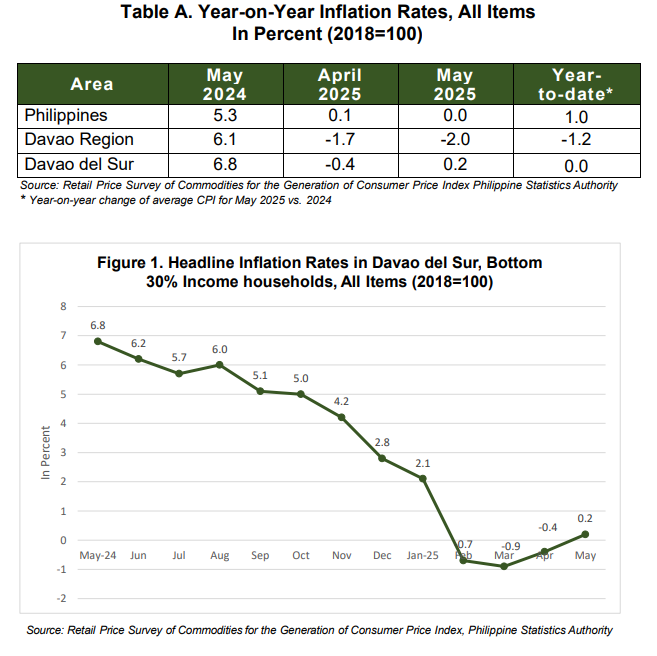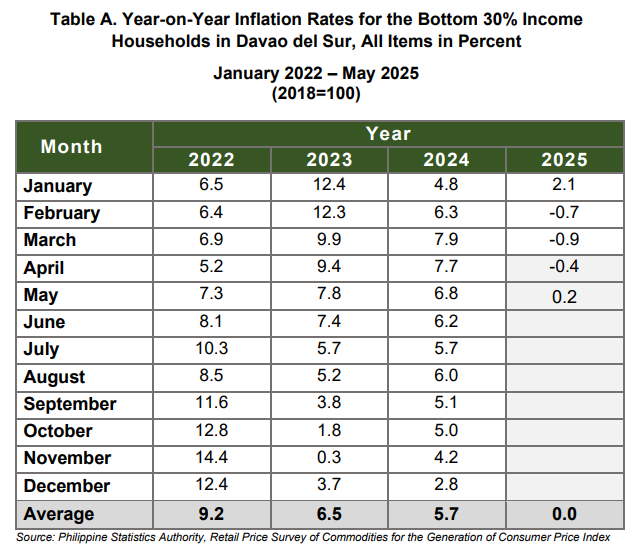
DAVAO DEL SUR
1. Headline Inflation
In May 2025, the headline or overall inflation of Davao del Sur for the Bottom 30% Income Households increased at 0.2 percent, reflecting a 0.6 percentage points higher from the April 2024 inflation rate of negative 0.4 percent. Remarkably, the current inflation rate was 6.6 percentage points lower than the figure reported in May 2024 at 6.8 percent. (Table A and Figure 1).
1.1 Main Drivers of the Uptrend of the Headline Inflation of the Bottom 30% Income Households
The increased inflation for the Bottom 30% Income Households in May 2025 of Davao del Sur was primarily due to (a) Food and Non-Alcoholic Beverages at negative 1.1 percent, from negative 1.7 percent in the previous month. Also contributing to the province’s headline inflation for the Bottom 30% Income Households was (b) Housing, Water, Electricity, Gas, and Other Fuels at 2.1 percent, from 0.1 percent in the previous month. The increased inflation for the Bottom 30% Income Households was also contributed by: (c) Personal Care, and Miscellaneous Goods and Services at 3.5 percent, from 2.7 percent in the last month, and (d) Restaurants and Accommodation Services at 1.1 percent, from 0.7 percent in the previous month.
On the other hand, the following commodity groups recorded slower price movements in May 2025 compared to April 2025:
a) Alcoholic Beverages and Tobacco at 6.7 percent, from 8.1 percent;
b) Furnishings, Household Equipment and Routine Household Maintenance at 4.0 percent, from 4.2 percent;
c) Health at 0.7 percent from 0.9 percent; and
d) Transport at negative 5.8 percent from negative 5.7 percent.
Meanwhile, certain commodity groups maintained the same rate as in the previous month. These were: (a) Information and Communication at 10.9 percent; (b) Recreation, Sport and Culture at 5.9 percent; (c) Education Services at 4.7 percent; (d) Clothing and Footwear at 2.4 percent; and (e) Financial Services at 0.0 percent.

2. Food Inflation
The food inflation for the Bottom 30% Income Households in Davao del Sur increased to negative 1.4 percent in May 2025 from negative 2.1 percent in April 2025. This increased food inflation for the Bottom 30% Income Households was attributed to the following groups:
a) Cereals and cereal products at negative 11.8 percent, from negative 13.1 percent in the previous month;
b) Ready-made food and other food products at 1.2 percent, from 0.1 percent in the previous month;
c) Milk, other dairy products and eggs at 11.5 percent, from 9.2 percent in the previous month; and
d) Fish and other seafood at 4.6 percent, from 3.8 percent in the previous month;
In contrast, the following food commodities showed lower inflation rates for Bottom 30% Income Households:
a) Vegetables, tubers, plantains, cooking bananas and pulses at negative 5.6 percent from negative 4.8 percent in the previous month;
b) Sugar, confectionery and desserts at negative 4.2 percent, from 1.5 percent in the previous month;
c) Fruits and nuts at 7.8 percent, from 9.3 percent in the previous month;
d) Meat and other parts of slaughtered land animals at 6.9 percent from 8.2 percent in the previous month; and
e) Oils and Fats at 76.2 percent from 76.8 percent in the previous month.
Technical Notes:
Consumer Price Index (CPI) - The CPI is an indicator of the change in the average retail prices of a fixed basket of goods and services commonly purchased by households relative to a base year.
Inflation Rate (IR) - The inflation rate is the annual rate of change, or the year-on-year change of the CPI expressed in percent. Inflation is interpreted in terms of declining purchasing power of money.
Bottom 30% Household - Families that belong in the low-income bracket and the most vulnerable to economic and social difficulties. Based on the “relative poverty” concept, a household whose per capita income falls below the bottom 30% of the cumulative per capita distribution belongs to the low-income group.
One of the common characteristics of households in this income group is that expenditures on food items account for a more substantial proportion of expenditures compared to expenditures on other items. Price changes in food, therefore, would be expected to greatly affect this income group more than any other group.
Headline Inflation - measures changes in the cost of living based on movements in the prices of a specified basket of major commodities. It refers to the annual rate of change or the year-on-year change in the Consumer Price Index (CPI).
Approved for Release:
ADELINE G. BATUCAN
(Supervising Statistical Specialist)
Officer-In-Charge
Davao del Sur Provincial Statistical Office
